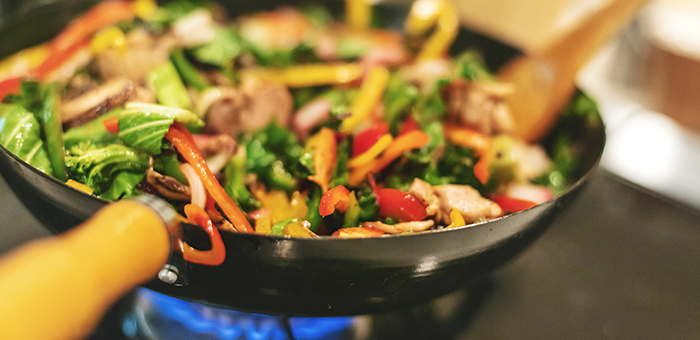How to Go Green

The blog post Why to Go Green highlights some of the health benefits of eating green vegetables. However, it’s not necessarily what you eat that makes a difference to health, but rather what you absorb. The concentration and bio-availability of polyphenols, glucosinolates, sulforaphane, vitamin C and selenium in green vegetables can vary depending on how they are cultivated, processed, prepared and cooked (1). Many green vegetables come under the umbrella of the brassica family, also known as cruciferous vegetables, which includes broccoli, cabbage, Brussels sprouts, rocket and kale.
Here’s what the research says about how to optimise your body’s absorption of the health giving properties of green vegetables:
Steaming and drying – steaming or dehydrating increases the bio-availability of beneficial sulforaphane and increases the antioxidant activity of broccoli (1).
Steaming, microwaving and stir-frying – do not lead to loss of glucosinolates and related isothiocyanates from brassicas, whereas boiling leads to losses through leaching into cooking water (2).
Add mustard – adding mustard seeds to boiled broccoli makes up for some of the losses caused by cooking (3).
Freezing and boiling – broccoli that has been frozen or boiled has diminished polyphenol concentration, partly due to leaching into the water. This means that cooking vegetables in a soup or stew where the water is consumed is preferable to cooking the vegetables separately and discarding the water. If you do boil your vegetables save the cooking water and keep it in the fridge to use in soup, stock or gravy.
Cook in oil – cooking vegetables in oil, as in stir fries, increases the bio-availability of beta-carotene (4). Use unrefined oil such as olive oil or coconut oil.
Finely sliced – cabbage leaves that have been shredded or finely sliced have greater benefits than whole leaves (5).
Add dressing – mixing shredded cabbage leaves with an oil based dressing results in an even greater release of beneficial compounds (5). However, vegetables that are finely shredded and not mixed with oil experience a marked decline in glucosinolates, losing 75% over 6 hours.
Combine – eating a combination of cruciferous vegetables is likely to provide more benefits than eating them separately (6).
Here are some tips on how to incorporate green vegetables into your meals:
Bubble and Squeak – fry left over cooked cabbage or Brussels sprouts with mashed potato for a deliciously comforting meal.
Coleslaw – add shredded red or green cabbage to grated carrots for a home made coleslaw. Instead of mayonnaise stir in an olive oil and lemon juice dressing with a dash of tamari soy sauce and some toasted seeds.
Curries – cauliflower and broccoli florets are tasty additions to curries.
Salads – add watercress or rocket to lettuce and other salad leaves. Sprinkle on a dressing of olive oil, mustard and cider vinegar to increase nutrient absorption.
Stews and Casseroles – whatever stew or casserole you are making add some florets of broccoli or cauliflower and a handful of finely chopped kale.
Stir fries – add broccoli florets, shredded cabbage or chopped kale to stir fries.
Go herby – herbs are concentrated sources of green goodness. Add them soups, stews, casseroles and dips.
For some inspiring green recipes see the blog post Green Dreams Recipes.
References
1. Mahn A, Reyes A. n overview of health-promoting compounds of broccoli (Brassica oleracea var. italica) and the effect of processing. Food Sci Tech Int. 2012 Dec;18(6):503-14.
2. Food Chem Toxicol. 2007 Feb;45(2):216-24. Effect of storage, processing and cooking on glucosinolate content of Brassica vegetables. Song L et al.
3. J Food Sci. 2014 Sep;79(9):S1756-62. Consumer acceptability and sensory profile of cooked broccoli with mustard seeds added to improve chemoprotective properties. Ghawi SK, Shen Y, Niranjan K, Methven L.
4. Plant Foods Hum Nutr. Winter 2004;59(1):1-9. In vitro accessibility and intake of beta-carotene from cooked green leafy vegetables and their estimated contribution to vitamin A requirements. Mulokozi G et al.
5. Urikura M, Morishige J, Tanaka T, Satouchi K. Phosphatidic Acid production in the processing of cabbage leaves. J Agric Food Chem. 2012 Nov 14;60(45).
6. Int J Vitam Nutr Res. 2003 Mar;73(2):135-43. Non-nutritive bioactive constituents of plants: dietary sources and health benefits of glucosinolates. Lund E.